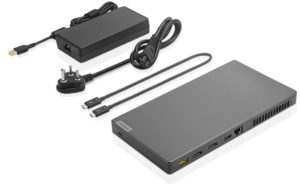Article

Lenovo Thunderbolt 3 Graphics dock – a Thunderbolt 3 business docking station that has external graphics module functionality
My Comments
In the average business context, Thunderbolt 3 is seen primarily as a powerful “connection pipe” for port-replication docks. The external-graphics-module benefit isn’t considered an advantage in this use case unless the user is doing multimedia editing, computer programming or number-crunching workloads involving large data sets.
But in 2018, Lenovo issued to the US market and some other markets their Thunderbolt 3 Graphics Dock (model: G0A10170UL) that has external-graphics-module functionality as well as port-replication dock functionality which includes RJ45 Gigabit Ethernet connectivity. This uses a soldered-in NVIDIA GTX 1050 graphics processor and 4Gb display memory, with this GPU considered as the economy model in NVIDIA’s desktop-class dedicated graphics processor lineup.at the time of release.
The Lenovo Thunderbolt 3 Graphics Dock is not just seen as being fit for a desktop workspace but also being fit for travel. This is due to its relatively small size compared to the typical “card-cage” external graphics module. It is because the device has the same size and weight as the typical business-class port-replicator dock with the power supply unit being of a similar size to those that accompany this class of product.
The article mentioned that, at the time of review, there were issues with software bugs including not cooperating with onboard dedicated graphics setups in some laptops. Usually this will have been rectified through firmware, BIOS and driver updates that should have taken place by now.
But, like a lot of small external graphics modules that have soldered-in graphics silicon, the capability may be enough to give your laptop a bit of extra “pep” for some non-demanding graphics-based tasks. This may be about lightweight photo and video editing or people who aren’t really “core” gamers.
The Windows Central article also raised the prospect of number-crunching activities with large data sets. But the problem that shows up here is that regular office productivity software, especially spreadsheet software like Microsoft Excel, doesn’t offer the ability to take advantage of high-performance computing setups like discrete graphics processors.
As I have mentioned before, the combination of Intel integrated graphics and Thunderbolt 3 connectivity for a laptop computer can encourage the use of external graphics modules as a fit-for-purpose upgrade path. This is being underscored with Intel Tiger Lake silicon that comes with Intel Xe integrated-graphics silicon that is highly capable compared to before along with Thunderbolt 4 connectivity compatible with Thunderbolt 3 hosts and peripherals.
It is also another example where Lenovo thought outside the box when it came to offering external graphics modules. Here, the Lenovo Legion BoostStation “card-cage” external graphics module didn’t just come with the space to install a graphics card, but it also came with space to install a 2/5” or 3.5” SATA-connected hard disk or solid-state drive. This is compared to a lot of “card-cage” types that only have capacity to install a graphics card and can woo those of us moving away from desktops to laptops.
By seeing the idea of external-graphics-module products pitched towards everyday business users and their cost-conscious IT departments, it could legitimise this product class towards mainstream computer users. But further work needs to take place to see a wider range of business-class eGPU docks with differing peripheral-connection and graphics-silicon options, including whatever offers mid-tier multimedia-creation abilities, and to see multiple vendors offer these docks to the market.
Mainstreaming these external-graphics-module devices can also make them appeal to user classes who don’t necessarily have the disposable income to spend on high-performance computing. This is due to downward pressure on these devices’ prices and can be facilitated by Intel becoming a third force when it comes to performance-level graphics silicon.


